Why tomato seedlings have purple leaves and stems: reasons and what to do, how to fertilize
Let's guess, "Your tomato seedling suddenly turns purple and you don't know what to do."
There are not so many reasons, and they are all solvable, which means, most likely, the outcome will be positive. So don't panic!
Now you will find out why the leaves and stems of tomato seedlings can turn purple, and what steps you need to take to return your plants to their normal color.
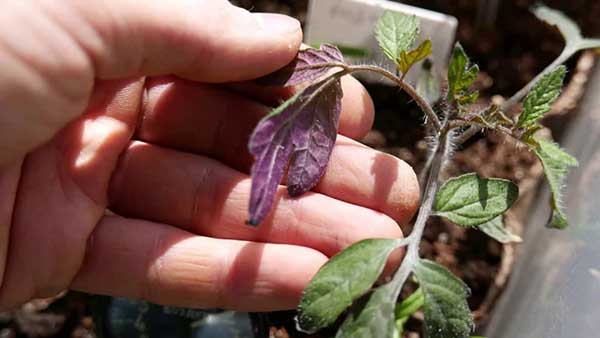
Content
Tomato seedlings turned purple: reasons and what to do
So, as mentioned earlier, there are only a few reasons for this phenomenon (changing the color of leaves and stems of tomato seedlings to purple):
- varietal feature (rare);
- the seedlings are cold - they froze on your cold windowsill, or you specially took them out for hardening (often);
- lack of phosphorus (often).
By the way! Reasons 2 and 3 are quite closely related.
Next, we will analyze each reason separately, and how you should act in each specific situation.
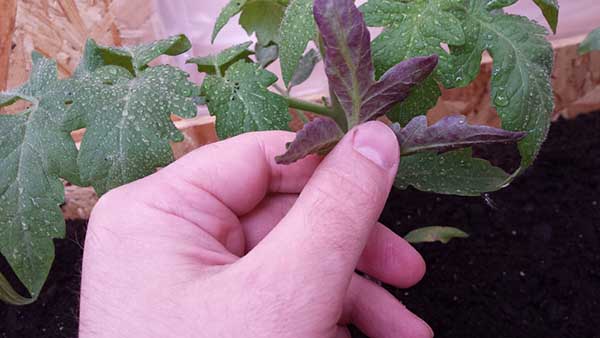
Varietal characteristic
If your tomato seedlings are in the initial stage of their development the stem below the cotyledons is already purple, then, most likely, this is such a varietal feature (sign). For example, this phenomenon is often observed in the variety "Bull Heart", in many black (blue) tomatoes... But this concerns exactly the stems of the plant, not the leaves!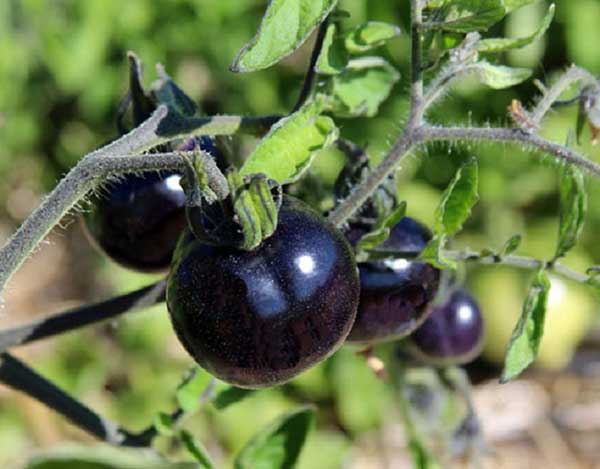
Lowering the temperature (during hardening)
Very often, seedlings are grown on a windowsill, where it is very cold, especially if the frames are old and wooden, and pulls cold from the cracks. Here are the tomato seedlings and turn purple.
Sometimes they also say “turned blue” = frozen.
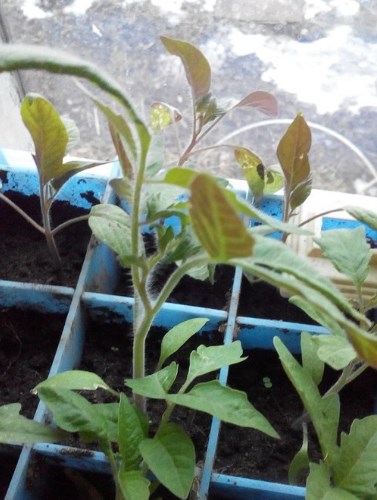
As you know, the purple color of the plant is given by anthocyanin pigments. Accordingly, when the temperature drops, tomato seedlings begin to synthesize more anthocyanin pigments (they help the plant to protect itself from the cold).
As a rule, in this case, both the stems of the plant and the leaves acquire a purple color.
Interesting! That is why many summer residents specially achieve a purple hue tomato seedlings in front of her landing in open ground or greenhousesince believe that such a shade is a clear sign that she (seedlings) strong and seasoned.
How are seedlings hardened?
They ventilate the room where the seedlings are standing by opening a window at night or taking them to an open balcony, to an even cooler greenhouse.
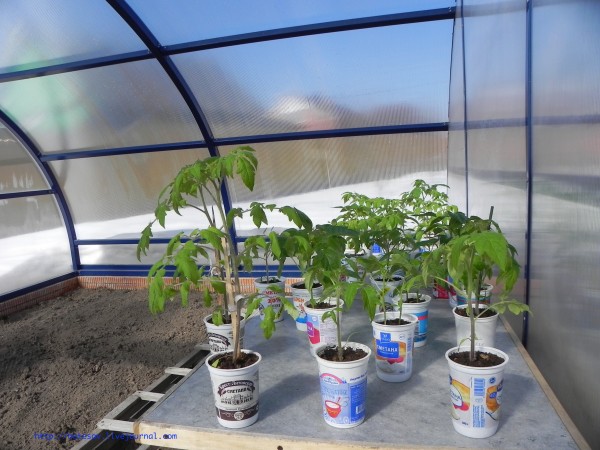
If, after increasing the temperature, the color of the foliage and stems of tomato seedlings did not become a normal shade, then perhaps the matter is in the following reason.
Phosphorus deficiency
Often purple leaves say that tomato seedlings are experiencing phosphorus starvation, and in this case, the purple hue acquires exactly reverse side of the sheet... In this case, the stems usually do not change color.
The color of the foliage does not have to be exactly purple, sometimes it reddish purple (burgundy).
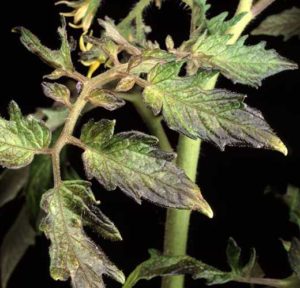
Worth knowing! Phosphorus is especially important for the plant at the initial stage of its development (because it is responsible for the root system), as well as during flowering and fruit formation.
Tomato leaves turned purple due to lackphosphorus: features of manifestation, necessary feeding
In the case of a phosphorus deficiency, a purple color at first acquire older (lower) seedling leaves (since phosphorus itself is not very mobile), and then younger (upper) leaves, which also gradually turn purple.
In case of severe phosphorus starvation top gets dark green colorand older leaves can age prematurely. They also can curl.
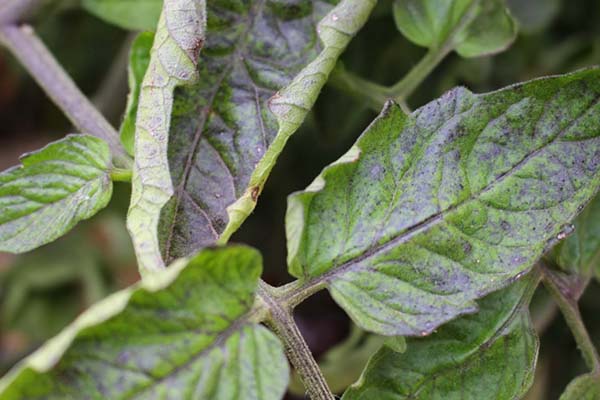
By the way! About, how else is the lack of phosphorus manifested, for which this most important nutritional element is responsible - read more in this article.
How not to confuse phosphorus and sulfur deficiencies
Note! With sulfur deficiencystems and petioles seedlings take purple (purple) color and can become fusiform. The color of the leaves remains almost unchanged (according to other sources, they become light green, slightly yellowish).
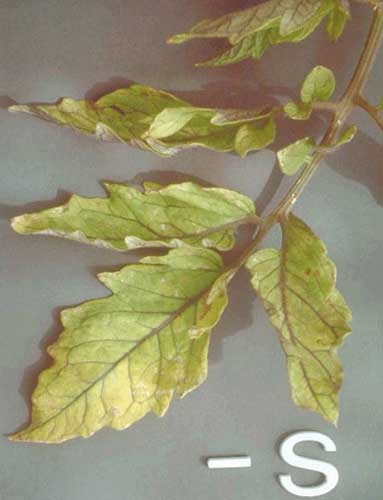
Causes of phosphorus deficiency
- In the soil no (not enough) phosphorus, in other words, you initially forgot to deposit it or did not deposit enough (too little).
Urgently needed perform phosphorus feeding.
- There is a sufficient amount of phosphorusah, but he inaccessible (inaccessible) to plantssince it was blocked (tied up) by another food element due to increased or decreased acidity of the soil.
Phosphorus needed mobilize (= turn into plant-accessible form).
- Too low soil and environmental temperature, due to which the root system of the plant simply cannot absorb phosphorus (as a rule, at soil temperature below +12, and air below +14 degrees).
Obviously you need raise the temperature for the absorption of phosphorus by the plant.
How to feed, what phosphorus fertilizers to use
If there is enough phosphorus in your soil, but it is blocked, then you can apply a bacterial preparation -Phosphatovite.
Phosphatovite contains bacteria that convert insoluble phosphorus (as well as potassium) compounds into a form available to plants.
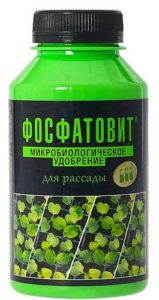
Or feed the plant digestible phosphorus:
- potassium monophosphate solution (phosphorus - 50%, potassium - 33%).
Moreover, you can carry out top dressing (spraying) directly on the leaves (i.e. foliar).
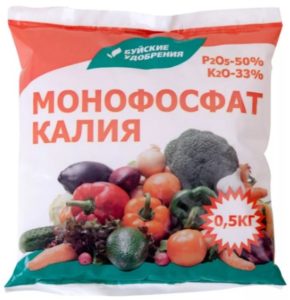
- to cook superphosphate infusion (preferably double) and shed at the root.
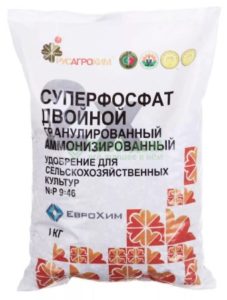
By the way! The site already has an article about how to prepare a fast-digesting superphosphate extract (preferably double).
- specialized fast-dissolving and readily available fertilizer type Agricola for tomatoes, peppers and eggplants (can be both under the root and on the leaves).
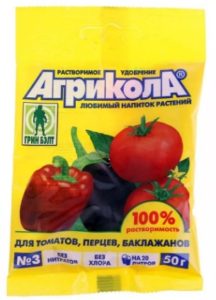
Well, now you figured out what was the reason for the change from the green color of the leaves and / or stems of your tomatoes to purple? We hope that nothing serious ... You will not have to reseed, otherwise you never know! Okay, just kidding and that's enough! Not such a terrible phenomenon. Much worse if the leaves of the seedlings began to turn yellow and dry..
Note! No matter how quickly you react, the purple leaves are unlikely to be able to return to their normal state, but you can save the plant itself, and all the new leaves will definitely be green.
However, if the reason was not a strong phosphorus starvation, then, most likely, the tomatoes will gradually regain their green color.

